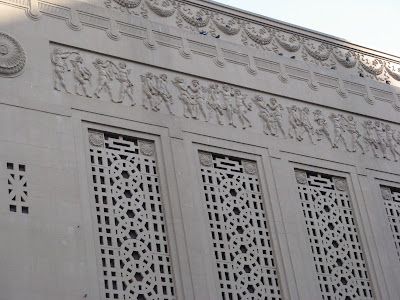The Civic Theatre was built in 1929 and is a superb example of an atmospheric cinema. This style of architecture was developed by the Austrian/American architect, Eberson, during the period known as the "golden age of hollywood", a time when cinema, while still a novel experience, was reaching out to a mass audience. The idea behind an atmospheric cinema was to transport the audience to a world of exoticism and romance and to give them a more complete sensory experience at a time when most films were still silent.
 |
| The Civic Theatre, Auckland. In the lower left hand corner you can see The Force Cinema Complex |
The Civic is still a busy working cinema and theatre and as it is a home to the New Zealand International Film Festival I still go there regularly. I never fail to delight in it and tilt my head back before the film starts to make sure I see at least one shooting star cross the sky.
 |
| Is it a castle? |
 |
| Or a ship? |
Much has changed in the movie industry in the more than 90 years since the Civic Theatre was built. The improvement in sound technology, in cinematography, in acting and the use of music have all led to film itself becoming a more sensory experience. There is, therefore, no need to distract the audience and/or enhance the film with elaborate surroundings. The philosophies behind the designs of the Civic Theatre and the Force Imax Centre are quite different and provide us with an apt commentary on the history of cinema. On the one hand we have the Civic which seeks to transport its audience to a magical and exotic world through the architecture of the building and on the other hand we have the Imax Theatre which is at pains not to distract the audience from the magical and exotic world portrayed in the films themselves. Both buildings are, in my opinion, architectural treasures.
footnote: the Force cinema complex has changed hands and is now known as Event Cinemas and, sadly, the large book shop is now a bowling alley.

No comments:
Post a Comment